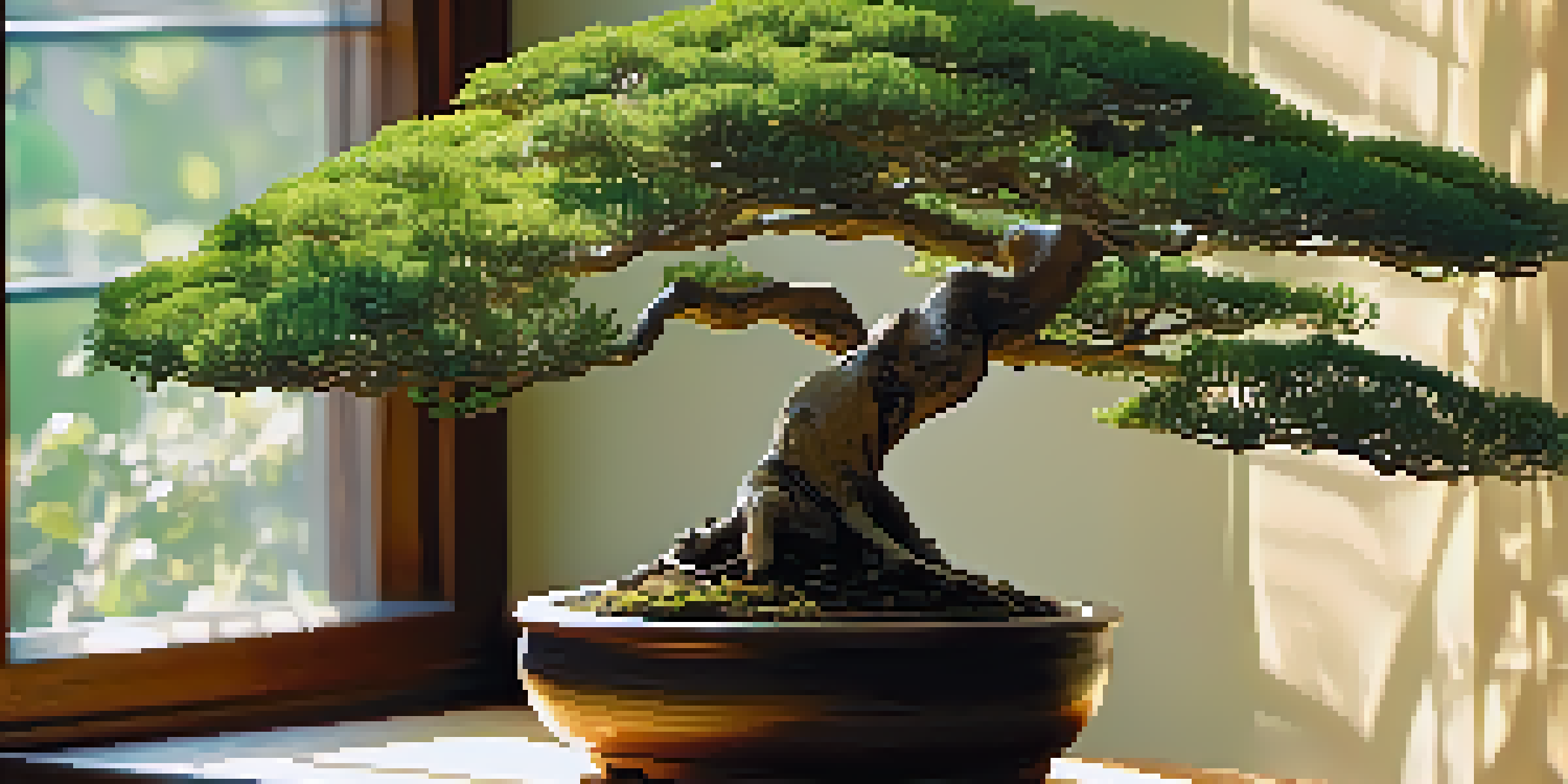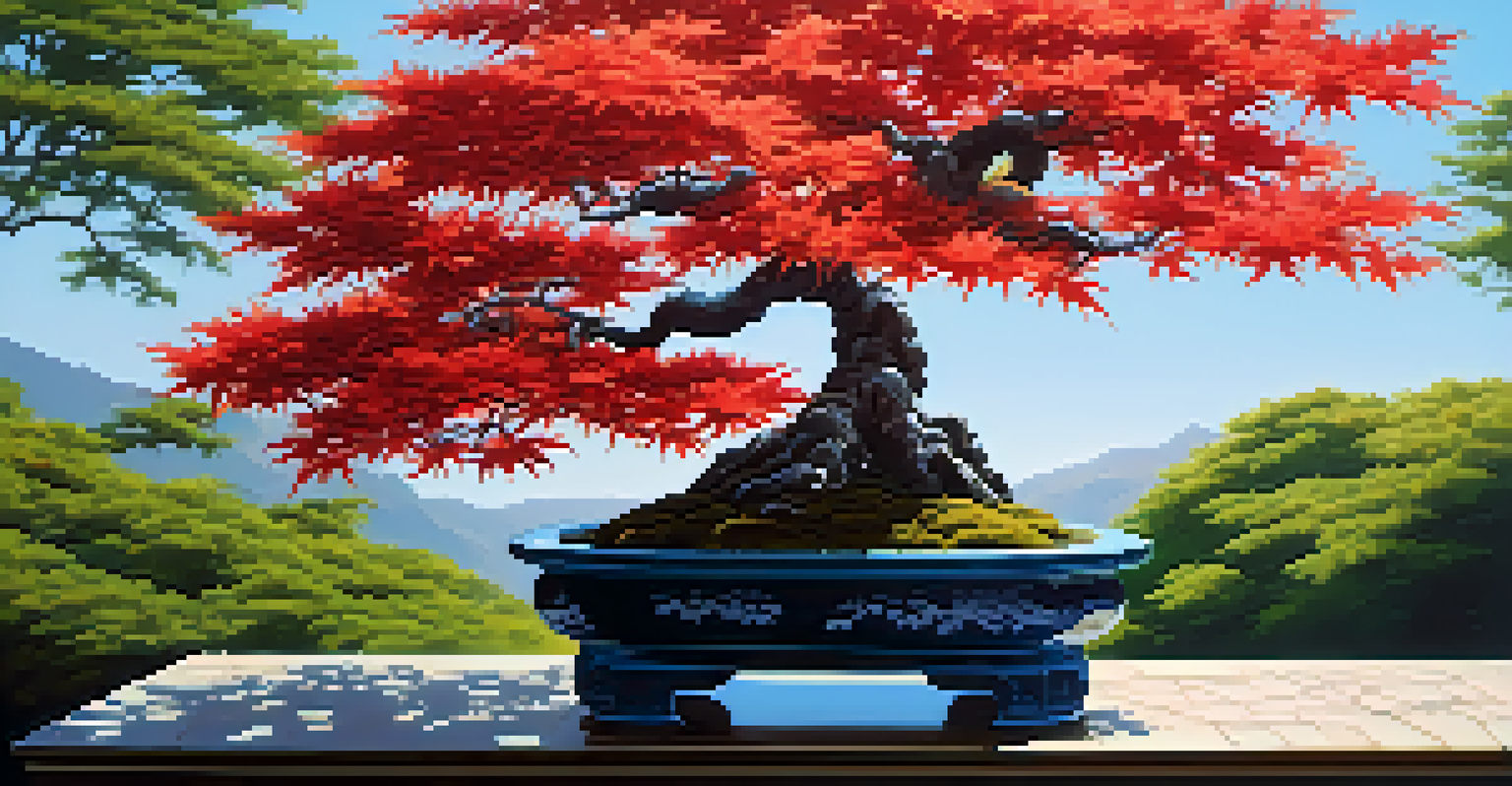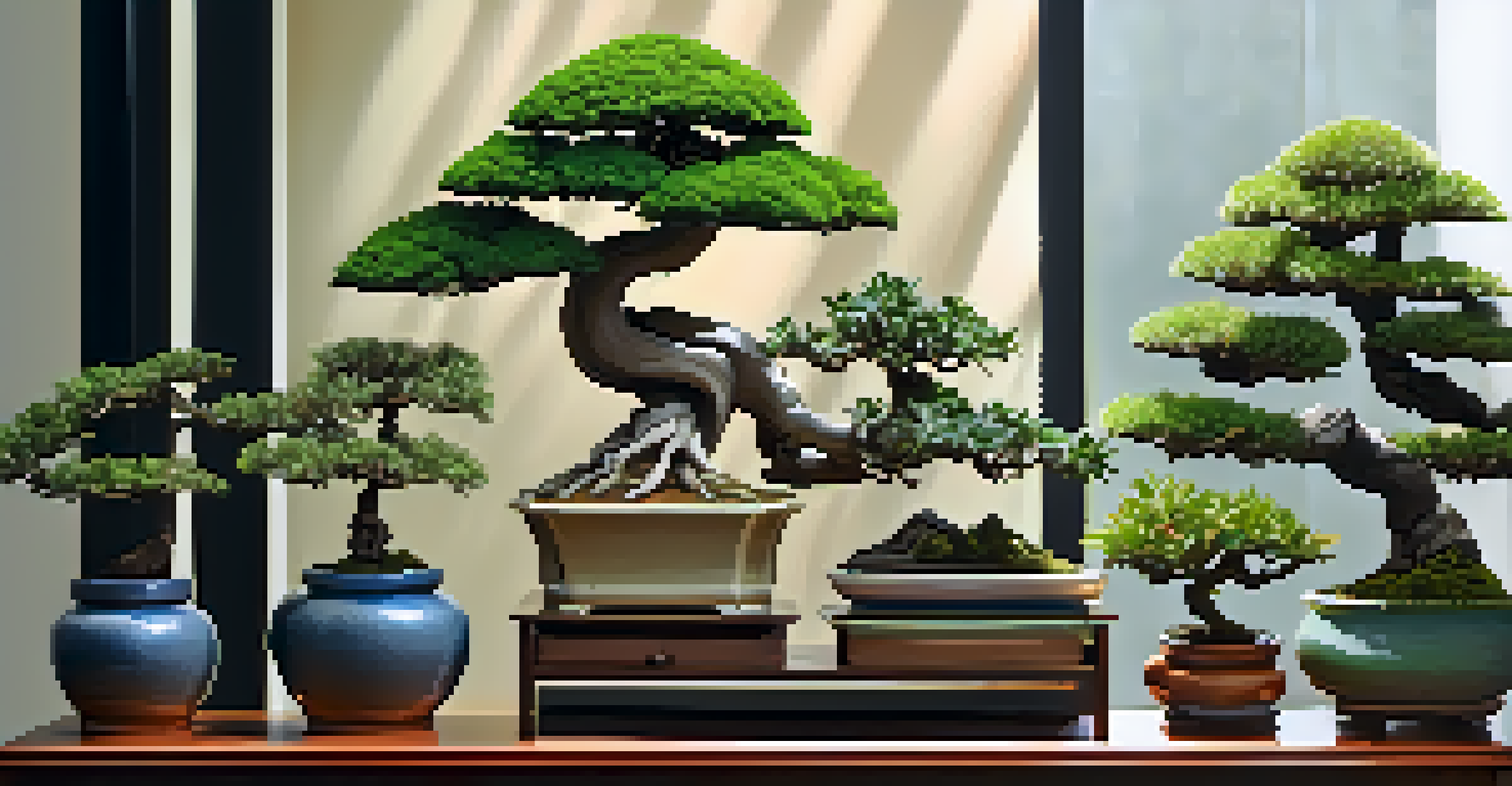Indoor vs. Outdoor Bonsai: Key Differences and Care

Understanding the Basics of Bonsai Trees
Bonsai trees, which originate from the Japanese art form, are miniature versions of larger trees. They can be cultivated indoors or outdoors, each requiring specific care and conditions. Understanding the basic principles of bonsai is crucial to ensure these beautiful plants thrive, regardless of their environment.
The creation of a bonsai is not just a matter of growing a tree, but an art of patience, precision, and understanding of nature.
The primary goal of bonsai cultivation is to create a sense of harmony and balance, mimicking nature in a small pot. It's important to note that while all bonsai share this artistic aspect, they differ significantly in terms of care based on their setting. This distinction can affect their growth, appearance, and overall health.
As we dive deeper into the key differences between indoor and outdoor bonsai, you'll find that each type has unique characteristics and care requirements. By understanding these differences, you can choose the right bonsai for your lifestyle and ensure that it flourishes.
Key Characteristics of Indoor Bonsai Trees
Indoor bonsai trees are typically chosen for their ability to thrive in lower light conditions and stable indoor environments. Common indoor species include the Ficus, Jade, and Chinese Elm, each offering unique aesthetics and care needs. These trees are often smaller and more compact, making them ideal for home or office settings.

One of the key factors to consider when caring for indoor bonsai is humidity. Indoor air tends to be drier, especially in winter months, so maintaining adequate moisture is vital. Regular misting, using a humidity tray, or investing in a small humidifier can help keep your bonsai healthy and vibrant.
Indoor Bonsai Needs Special Care
Indoor bonsai require specific humidity, light, and watering conditions to thrive in a home environment.
Additionally, indoor bonsai require proper watering and fertilization, which can differ from their outdoor counterparts. Overwatering is a common mistake, so it's essential to check the soil moisture regularly and adjust your care routine accordingly to avoid root rot.
Essential Care Tips for Indoor Bonsai
When it comes to indoor bonsai care, lighting is crucial. These trees thrive in bright, indirect light, so placing them near a window that receives filtered sunlight can work wonders. However, be cautious of direct sunlight, which can scorch the leaves and impede growth.
Gardening adds years to your life and life to your years.
Another important aspect of indoor bonsai care is pruning. Regular pruning not only helps maintain the desired shape but also encourages healthy growth. You should aim to prune your bonsai during the growing season, typically in spring and summer, to promote new foliage.
Lastly, don't forget to repot your indoor bonsai every couple of years to refresh the soil and provide it with nutrients. Choosing the right pot size is critical; a pot that’s too large can lead to excessive root growth, while one that’s too small can restrict its growth. Balancing pot size and soil quality is key to a thriving indoor bonsai.
Key Characteristics of Outdoor Bonsai Trees
Outdoor bonsai trees are well-suited for natural light and outdoor conditions, allowing them to grow larger and more robust. Species like the Japanese Maple, Pine, and Juniper are popular choices for outdoor bonsai due to their resilience to changing weather. These trees often exhibit beautiful seasonal changes, adding to their visual appeal.
One significant difference between indoor and outdoor bonsai is their exposure to the elements. Outdoor bonsai can benefit from natural rainfall, sunlight, and wind, which help strengthen their structure. However, this also means they are more susceptible to pests and harsh weather conditions, requiring vigilant care.
Outdoor Bonsai Thrive in Nature
Outdoor bonsai benefit from natural sunlight and weather changes, but need protection from extreme conditions.
In addition, outdoor bonsai need a dormancy period during winter, which is essential for their lifecycle. Providing adequate protection during colder months, such as mulching or placing them in a sheltered spot, can ensure they survive and thrive as the seasons change.
Essential Care Tips for Outdoor Bonsai
Caring for outdoor bonsai comes with its own set of guidelines, primarily focused on the environment. Positioning your bonsai in a spot that gets ample sunlight is crucial, as most outdoor species thrive in full sun. However, be mindful of extreme heat, which can lead to dehydration, and provide shade during the hottest parts of the day when necessary.
Watering outdoor bonsai is also different; they often require more frequent watering compared to indoor varieties due to exposure to wind and sun. Checking the soil moisture regularly is vital, especially during dry spells, to ensure they receive adequate hydration without becoming waterlogged.
Pruning and wiring outdoor bonsai should be done with care, especially during the growing season. It's essential to shape them correctly to encourage healthy growth and maintain their aesthetic appeal. Remember, each species may have its own preferred pruning techniques, so researching specific needs is beneficial.
Common Mistakes to Avoid for Indoor Bonsai
One of the most common mistakes with indoor bonsai is overwatering. New bonsai enthusiasts often assume that these trees need constant moisture, but this can lead to root rot and other issues. Always check the soil before watering to ensure it’s dry enough to need moisture.
Another frequent error is neglecting to provide adequate light. Many indoor bonsai owners underestimate the importance of light and place their trees in too dim an environment. Remember, while they can tolerate lower light, they thrive best with bright, indirect sunlight.
Avoid Common Bonsai Care Mistakes
Both indoor and outdoor bonsai caretakers should be aware of key mistakes, such as overwatering and neglecting light requirements.
Finally, failing to fertilize appropriately can stunt growth. Indoor bonsai need nutrients to flourish, so using a balanced fertilizer during the growing season can make a significant difference. Understanding your tree's specific needs can help avoid these common pitfalls.
Common Mistakes to Avoid for Outdoor Bonsai
Outdoor bonsai caretakers often make the mistake of ignoring weather conditions. Sudden temperature changes or extreme weather can stress the trees, so being mindful of the forecast is essential. Providing protection during harsh weather can save your bonsai from potential damage.
Another common oversight is not pruning regularly. Many outdoor bonsai enthusiasts think they only need to prune once in a while, but regular maintenance is key to a healthy shape and structure. Regular pruning encourages new growth and keeps the tree looking its best.

Lastly, it's easy to overlook pest control for outdoor bonsai. Being exposed to the elements means they can attract insects or diseases more readily. Regularly inspecting your trees and acting quickly at the first sign of trouble can prevent larger issues down the line.